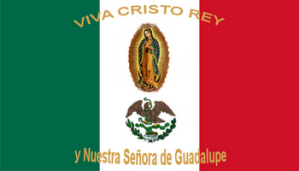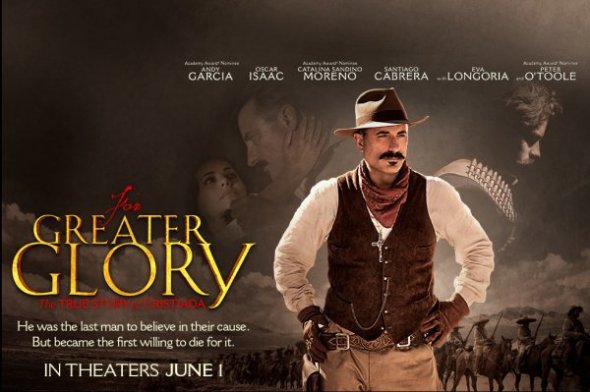Viva Cristo Rey; Long live Christ the King! This was the battle cry of the Cristeros, religious freedom fighters who defended their faith during the persecution of the Catholic Church in Mexico from the mid 1926 to 1929.
Today I would like to share with you a little known part of Mexican History with a concentration on the Cristero Wars that occurred from 1926-29. I will touch upon Mexico’s struggle to build a democracy, the reclaiming of lands, the Constitution of 1917, and the factors involved that led to the government in Mexico outlawing Catholicism on a whole. But before I can explain how and why this occurred I must first explain what led to the persecution and to do that we need to touch upon the history that led up to the Cristero Revolt against the Mexican Government.
After gaining her independence from Spain in 1821 Mexico began over a course of 100 years to build a democracy of its own. A little over a decade later in 1833, the clergy was excluded from teaching in the public schools. The reclaiming of lands had been a heated issue and between the years of 1855 and 1857 the government took back the land that was claimed by the Church during the Spanish Conquest 400 years prior. The government headed by President Benito Juarez issued numerous edicts which are known in Mexican history as the Laws of Reform. The first decreed the absolute separation of Church and state. Others nationalized all Church-owned land; prohibited public officials from attending religious services; made tithing illegal; abolished male monastic orders; prohibited female orders from accepting new members; made civil marriage obligatory and legalized divorce.
In 1877, General Porfirio Diaz seized power and ruled Mexico for the next 34 years. Diaz, wanting to maintain stability and order, didn’t enforce the restrictions on the Church through the Constitution like his predecessors. By the 1890s the Mexican Congress began a series of meetings out of which trade unions were organized, schools of agriculture and the arts were established, the public health systems were improved, and there was even a campaign against unjust labor contracts.
Then, in 1910, a revolt against Diaz was launched by Francisco I. Mader. He ruled until 1913 until he was overthrown and murdered by General Victoriano Huerta. Huerta was soon opposed by another group of revolutionaries calling themselves the Constitutionalists. Their leader, a state governor named Venustiano Carranza, was prepared to allow the Church some rights, like maintaining her school system, but he was outnumbered in his group’s leadership by men wanted to “liberate” Mexicans from the private practice of religion. By mid-1914 the Constitutionalists seized church buildings and jailed or exiled bishops, priests and nuns.
Their activities increased with The Constitution of 1917 which set out to enforce social rights through a series of laws known as articles. Article 3 required that all elementary education, public or private, to be run by the government; Monastic vows as well as monastic orders were outlawed by Article 5. Article 24 barred public worship. Church-owned buildings were declared to be property of the state by Article 27. Article 130 forbade all religious publications.
These articles were largely ignored by the clergy and after several tense years between church and state, at the end of February, 1926, the then President Calles sent a message to all state governors urging them to take immediate action toward the enforcement of the constitutional articles on religion. In a speech a few days later he declared: “As long as I am President of the Republic, the Constitution of 1917 will be obeyed.”
On July 2, 1926 the government published a decree of 33 articles which would become known as the “Calles Law.” Its effect was to require uniform enforcement on a nationwide basis of all of the constitution’s anti-Catholic provisions, and it spelled out penalties for infractions by officials who failed to enforce the law, as well as by private citizens.
On July 24 the Vatican decided to withdraw all their priests from all the nation’s churches. Sunday, August 1, 1926, for the first time in more than four centuries, no priest served morning Mass. Deprived of Mass, many of the people, who were mostly peasants living on the land revolted. Their revolt became la Cristiada, the Cristero Rebellion.
These peasant fighters called themselves Cristero’s and were known to exclaimed “Viva Cristo Rey! as their battle cry. The government treated these freedom fighters with the greatest contempt and brutality once captured. According to Author Jean Meyer “No prisoners were taken; civilians taken as hostages were murdered. Torture was systematic, and was used not only to obtain information but also to prolong suffering, and to oblige Catholics to renounce their faith, since death was not sufficient to persuade them to do this.
The actual war, raged mostly in states in the center and west of the country. There were a large number of refugees. A half-million Mexicans moved from the countryside and settled in cities. Another half-million made their way across the border into the U.S. This was how modern Mexican communities in cities like Los Angeles were built.
The Cristeros didn’t have much of a chance after the United States government sent Ambassador Dwight Morrow into Mexico to negotiate a deal with President Calles. Writer Jean Meyer said of Morrow: “The personal friendship that existed between the remarkable Ambassador Morrow and President Calles was accompanied by close political collaboration. Morrow, in his diplomatic capacity, played an essential role in the settlement of the religious conflict, and, as a financier, he assisted his Mexican colleague. Thanks to his good offices, the Government was able to purchase directly from United States arsenals ten thousand Enfield rifles, ten million rounds of ammunition, and aircraft with American pilots.”
Money remained a problem for the Cristeros until the very end, which was needed to buy rifles and ammunition. What money the Cristeros had was raised by themselves in three main ways: from a tax in territories they controlled; from the robbery of federal trains; and from kidnappings.
The ammunition came from the Women’s Brigades. Which consisted of 25,000 mostly unmarried women between the ages of 15 and 25. The Women’s Brigades smuggled ammunition right to the Cristeros: hiding the ammunition in coal and cement. They even devised ways of hiding bullets in there undergarments.
In the end 40,000 Cristeros died defending their Faith, while the government suffered a loss of 60,000 federales. The government expelled 400 foreign priests in 1926, while 3,600 priest remained in Mexico. Ninety of them would be executed before the war ended. In the states where the war was fought, there were no more than about 100 priests in the whole countryside. Fifteen of them served as Cristero chaplains. Five priests fought in the battles, two of them becoming generals. Another 25 actively assisted the rebellion anyway they could.
In 1929 the government and the Church came to terms. The Government refused to change the Constitution but agreed to be relaxed in its enforcement of it. On the government’s side, the war was too expensive and their debt to the American government kept getting bigger. From the Churches side, they were disturbed by the effects the closure of the churches were having on the faithful and the loss of human lives this conflict was responsible for. An arrangement was made and documents drawn up.
The documents of the arrangement were signed in Mexico City on June 21, 1929. Archbishop Diaz communicated to Gen. Degollado to order the Cristeros to lay down their arms as a matter of religious obedience. The Cristero fighters readily obeyed the Archbishops order. On July 3, less than two weeks after the arrangements were signed, Fr. Gen. Pedroza was shot by a government firing-squad. He was the very first of 5,000 Cristeros who were hunted down and murdered by the government in the next few years. Most of those who managed to survive fled to the United States.
This largely unknown part of Mexican history was recently portrayed in the film “For Greater Glory” starring Andy Garcia. In the government’s attempt to liberate itself from its past, to set up a democracy and to reclaim its land from what it looked upon as invaders, it forgot that the hearts of men are less likely to be conquered then their land. This miscalculation was responsible for an uprising that hurt the economy and caused the deaths of many of its citizens. I hope you learn a little bit of Mexican history that you never knew before and I hope this article will inspire you to learn more about this important time in the history of Mexico.
~ John Andrew Dorsey








Hello, I just found a copy of the commemorative Viva Cristo Rey poster you show with Christ, 3 lions and the Pope. It was in my late grandfather’s home in Mexico and is form the 1920’s. Where did you find your copy? Can you share any history? Thank you!
I found it on google image search and loved it. Perhaps you could tell me more about it.
At this time, Mexico was under 1 Party Rule and Freemasons controlled the Mexican Government.
Warren G. Harding was a 33rd Degree Scottish Rite Mason.
It was a case of One Mason aiding another, no matter how evil the action.
Hello,
One question. . .Who painted the Viva Cristo Rey, Christ the King procession?
I’ve looked all over the web and have seen the image in three other places.
Unfortunately no author of the image, let alone the title, has been found in my searching.
Your page, along with the following URL, provides the closest clue to the painting’s back story. . .when it was put to fruition and created.
https://goo.gl/pFjZ5N
The comment from 2014 is very promising and I hope you were able to reach out to them in an email.
Speaking of email, please email me for either if you know information about the piece or if you do not.
I am grateful for your reply and will anticipate it with patience.
Thank you and God bless.
–Adam K
Kneeling and on the tounge is the way to receive the King of Kings!
Viva Cristo Rey! 🙏